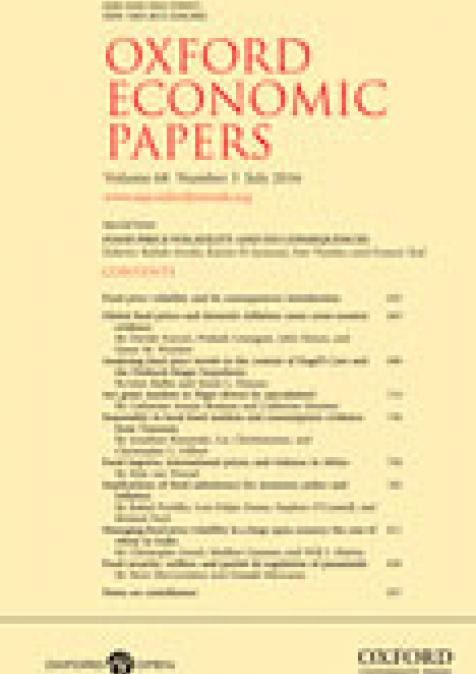RELATED CONTENT
-
 AuthorsJuly 14, 2016OCP Policy Center and its partners, the International Monetary Fund (IMF), and the Center for Technology and Economic Development (CTED) at the New York University are pleased to announce the publication of a Special Issue on "Food Price Volatility and its Consequences" in Oxford Economic Papers. The papers selected in this special issue were first presented in February 2014 at an international conference organized in Rabat in collaboration with the IMF's Research Department and t ...
AuthorsJuly 14, 2016OCP Policy Center and its partners, the International Monetary Fund (IMF), and the Center for Technology and Economic Development (CTED) at the New York University are pleased to announce the publication of a Special Issue on "Food Price Volatility and its Consequences" in Oxford Economic Papers. The papers selected in this special issue were first presented in February 2014 at an international conference organized in Rabat in collaboration with the IMF's Research Department and t ... -
AuthorsJuly 13, 2016Housing is part of the United Nations 11th Sustainable Development Goal, which is to “make cities inclusive, safe, resilient and sustainable”. One of the most important targets of such a goal is to “ensure access for all to adequate, safe and affordable housing1 and basic services and upgrade slums”. Since 2007, the world has faced rising inequality, insecurity and climate change impact. According to UN Habitat, 54% of the world´s population currently live in cities. By 2050, this n ...
-
 AuthorsJuly 11, 2016The Chinese economy is rebalancing while softening its growth pace. China’s spillovers on the global economy have operated through trade, commodity prices, and financial channels. The global reach of the effects from China’s transition have recently been illustrated in risk scenarios simulated for Latin American and the Caribbean economies. The Chinese economy is rebalancing while softening its growth pace… The weight of the Chinese economy in the global economy rose on its way t ...
AuthorsJuly 11, 2016The Chinese economy is rebalancing while softening its growth pace. China’s spillovers on the global economy have operated through trade, commodity prices, and financial channels. The global reach of the effects from China’s transition have recently been illustrated in risk scenarios simulated for Latin American and the Caribbean economies. The Chinese economy is rebalancing while softening its growth pace… The weight of the Chinese economy in the global economy rose on its way t ... -
Cristina BarriosJuly 07, 2016This podcast is performed by Cristina Barrios. As the EU shapes its new Global Strategy, the strategy for Africa is to trigger “a virtuous circle in the development-security-migration nex ...
-
 AuthorsJuly 4, 2016Suriname is facing twin - external and fiscal - deficits that originated in the commodity price slump of recent years. In response, the Surinamese government started a four-pronged adjustment program in August 2015 to adapt to new circumstances. Falling commodity prices led to multiple shocks on the Surinamese economy... On the back of favorable commodity prices and appropriate domestic policies, the Surinamese economy grew at an average rate of 5% per year - amongst the highest i ...
AuthorsJuly 4, 2016Suriname is facing twin - external and fiscal - deficits that originated in the commodity price slump of recent years. In response, the Surinamese government started a four-pronged adjustment program in August 2015 to adapt to new circumstances. Falling commodity prices led to multiple shocks on the Surinamese economy... On the back of favorable commodity prices and appropriate domestic policies, the Surinamese economy grew at an average rate of 5% per year - amongst the highest i ... -
-
-
-
AuthorsJune 30, 2016Latin American economies are facing two historically defining challenges. First, how to cope with the end of the commodities “super-cycle” and the prospect of a long period of low prices for basic natural resources. After all, raw materials production and semi-industrialized goods encompass most of their comparative advantages. Second, and even more exacting, how to adjust to the present disruptive transition from an old to a new global economic and social model. The 20th century in ...
-






